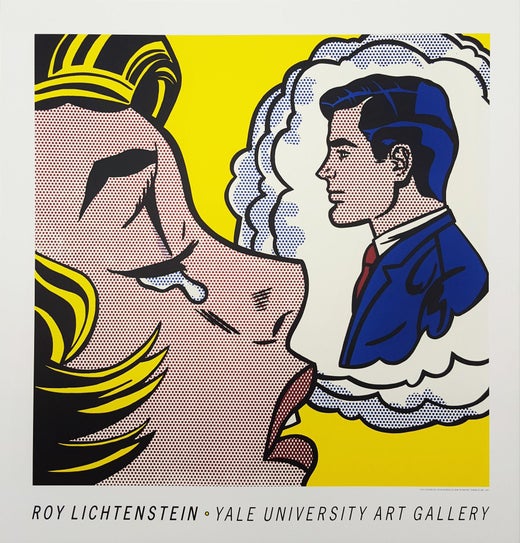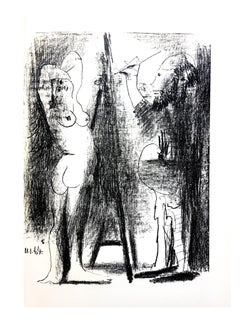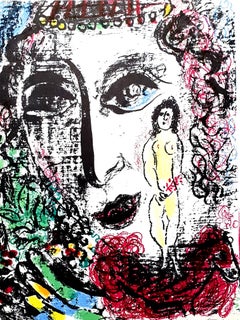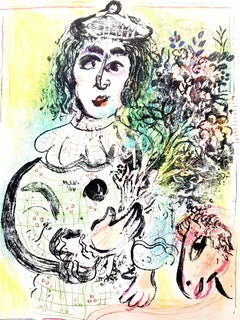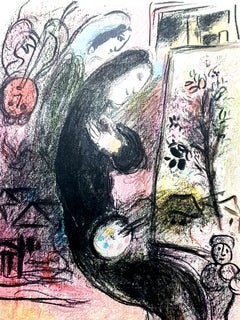Want more images or videos?
Request additional images or videos from the seller
1 of 11
(after) Roy LichtensteinAs I Opened Fire Poster - complete triptychafter 1966
after 1966
Price:$1,707.41
$1,897.12List Price
About the Item
- Creator:(after) Roy Lichtenstein (1928, American)
- Creation Year:after 1966
- Dimensions:Height: 25.2 in (64 cm)Width: 20.48 in (52 cm)Depth: 0.04 in (1 mm)
- Medium:
- Movement & Style:
- Period:
- Condition:
- Gallery Location:Collonge Bellerive, Geneve, CH
- Reference Number:1stDibs: LU16121655723
(after) Roy Lichtenstein
Roy Fox Lichtenstein (1923 – 1997) was an American pop artist. During the 1960s, he became a leading figure in the new art movement. He was heavily inspired by the comic strip as a visual medium, in particular the presence of the "Ben-Day" dots that are a result of the color and tone distillation of inexpensive printing. He described pop art as "not 'American' painting but actually industrial painting". Lichtenstein had his first one-man show in New York in 1962; the entire collection was bought by influential collectors before the show even opened. He would never take himself too seriously: "I think my work is different from comic strips — but I wouldn't call it transformation; I don't think that whatever is meant by it is important to art." When first exhibited, many art critics challenged its originality. His work was harshly criticized as vulgar and empty. The title of a Life magazine article in 1964 asked, “Is He the Worst Artist in the U.S.?” Lichtenstein responded to these claims by offering responses such as: "The closer my work is to the original, the more threatening and critical the content. However, my work is entirely transformed in that my purpose and perception are entirely different. I think my paintings are critically transformed, but it would be difficult to prove it by any rational line of argument."
About the Seller
4.9
Gold Seller
Premium sellers maintaining a 4.3+ rating and 24-hour response times
Established in 2015
1stDibs seller since 2015
967 sales on 1stDibs
Typical response time: 1 hour
Authenticity Guarantee
In the unlikely event there’s an issue with an item’s authenticity, contact us within 1 year for a full refund. DetailsMoney-Back Guarantee
If your item is not as described, is damaged in transit, or does not arrive, contact us within 7 days for a full refund. Details24-Hour Cancellation
You have a 24-hour grace period in which to reconsider your purchase, with no questions asked.Vetted Professional Sellers
Our world-class sellers must adhere to strict standards for service and quality, maintaining the integrity of our listings.Price-Match Guarantee
If you find that a seller listed the same item for a lower price elsewhere, we’ll match it.Trusted Global Delivery
Our best-in-class carrier network provides specialized shipping options worldwide, including custom delivery.You May Also Like
"The 6th International Biennial Exhibition of Prints in Tokyo"
By Tadanori Yokoo
Located in New York, NY
Tadanori Yokoo
"The 6th International Biennial Exhibition of Prints in Tokyo"
The National Museum of Modern Art, Tokyo, 1968
Offset lithograph poster
42...
Category
Mid-20th Century Pop Art More Prints
Materials
Lithograph, Offset
$8,500
H 45.5 in W 33.5 in D 1.5 in
Vintage Jim Dine poster Boymans Museum (Two Ties) red black 1970s retro pop art
By Jim Dine
Located in New York, NY
Original poster produced on the occasion of Jim Dine's 1971 exhibition at the Boymans Museum, Rotterdam. This vintage poster reproduces the artist’s lithograph Two Ties: neckties ske...
Category
1970s Pop Art Figurative Prints
Materials
Offset
Vintage James Rosenquist poster MOCA Chicago 1972 neon yellow pink chrome
By James Rosenquist
Located in New York, NY
An inverted car, gleaming in chrome, speeds through sumptuous layers of pink, translucent yellow, and a veil of lacy, flower-like shapes. Across the top, the artist’s name is splashe...
Category
1970s Pop Art Abstract Prints
Materials
Offset
Paolozzi Signed 1969 poster Galerie Mikro vintage futuristic psychedelic pop art
By Eduardo Paolozzi
Located in New York, NY
Printed in chartreuse, dark green, bright yellow, orange, and brown, this surreal scene features a grey-walled room populated with strange machinery and a red chair. Paolozzi creates...
Category
1960s Pop Art Figurative Prints
Materials
Offset
Vintage Jim Dine tool poster Kunsthalle Bern (Saw) neon blue 1970s retro font
By Jim Dine
Located in New York, NY
Original exhibition poster printed on the occasion of Jim Dine's 1971 exhibition at Kunsthalle Bern, featuring Saw, 1971. Against a sea of electric blue, Dine has written “saw” in lo...
Category
1970s Pop Art Figurative Prints
Materials
Paper, Offset
James Rosenquist Vintage Poster: Galleria del Milione 1972 full moon landscape
By James Rosenquist
Located in New York, NY
Silhouetted by the night sky, a brimmed hat perches on its stand, hovering above red-speckled ground like an aircraft. The moon shines bright white, and subtle clouds gather at the h...
Category
1970s Pop Art Figurative Prints
Materials
Offset
Vintage James Rosenquist Exhibition Poster Dundee City Art Gallery 1974 red
By James Rosenquist
Located in New York, NY
Vintage exhibition poster commemorating James Rosenquist's 1974 exhibition at Dundee City Art Gallery, Scotland. A flashy red border complements an abstract black and white image reproducing Rosenquist's 1972 lithograph Zone, which is based on the artist's 1961 painting with the same title.
"Text reads: Rosenquist Prints. Dundee City Art Gallery Albert Square Dundee DD1 IDA April 13th - May 11th 1974 Open Weekdays 10am-5pm Closed Sundays Admission Free. A Scottish Arts Council exhibition organised in association with the Petersburg Press...
Category
1970s Pop Art Figurative Prints
Materials
Offset
Vintage Jim Dine Green Bathrobe exhibition poster, 1970s retro pop art font
By Jim Dine
Located in New York, NY
This original, vintage poster on poster stock features one of Jim Dine's most iconic motifs: the bathrobe. In 1964, Dine saw an ad in the New York Times: “The ad shows a robe with the man airbrushed out of it. There was nobody in the bathrobe, but when I saw it, it looked like me.” Standing in for the artist's own body and rife with personal meaning, it provides a framework for limitless formal and stylistic experimentation. Here, the garment is colored bright green and defined by variegated black lines. Numbers label each part of the robe as in an anatomical chart. Bold black lettering reads Jim Dine, Petersburg Press...
Category
1970s Pop Art Figurative Prints
Materials
Paper, Offset
Vintage SIGNED 1969 Eduardo Paolozzi Poster avocado green psychedelic pop art
By Eduardo Paolozzi
Located in New York, NY
A vibrant vintage poster in blue, pink, brown, and classic 1960's avocado green, by Scottish Pop art progenitor Eduardo Paolozzi. Machinery extends upward in two arms like a space-age car engine...
Category
1960s Pop Art Figurative Prints
Materials
Offset
Original Batman Museo Dell'Automobile Torino vintage Italian poster
By (after) Andy Warhol
Located in Spokane, WA
Original poster: BATMAN - Museo Dell'Automobile Torino
Artist: after Andy Warhol.
Size 27.25" x 37" Printed: 1996 in Milan, Italy.
Excellent condition. This pop art Italian poster in perfect condition, ready to frame.
This is the original first printing of the Museo Dell'Automobile Torino (Italy) Batman, Andy Warhol. 'Viaggio in Italia'. This poster features the artwork for Warhol’s unauthorised 1964 film “Batman Dracula”. Excellent condition. Certificate of Authenticity. Printed in Italy. The exhibition poster was for Nov. 30, 1996 - March 9, 1997.
This BATMAN - Museo Dell'Automobile Torino is an Original Vintage Poster, not a reproduction. This poster is in excellent condition.
This is an Original Lithograph Vintage Poster; it is not a reproduction.
This is an Original Lithograph Vintage Poster; it is not a reproduction. Free Continental USA shipping included (saves $69 1st Dibs...
Category
1990s Pop Art Figurative Prints
Materials
Offset
$898 Sale Price
25% Off
H 37 in W 27.25 in D 0.05 in
More From This Seller
View AllPablo Picasso - Painter and His Model - Original Lithograph
By Pablo Picasso
Located in Collonge Bellerive, Geneve, CH
Pablo Picasso - Painter and His Model - Original Lithograph
1964
Dimensions: 30 x 20 cm
Edition of 200 (one of the 200 on Vélin de Rives)
Mourlot Press, 1964
Cramer, 128
Unsigned an...
Category
1960s Modern Abstract Prints
Materials
Lithograph
Marc Chagall - Original Lithograph
By Marc Chagall
Located in Collonge Bellerive, Geneve, CH
Marc Chagall
Original Lithograph
1963
Dimensions: 32 x 24 cm
Reference: Chagall Lithographe 1957-1962. VOLUME II.
Condition : Excellent
Marc Chagall (born in 1887)
Marc Chagall was born in Belarus in 1887 and developed an early interest in art. After studying painting, in 1907 he left Russia for Paris, where he lived in an artist colony on the city’s outskirts. Fusing his own personal, dreamlike imagery with hints of the fauvism and cubism popular in France at the time, Chagall created his most lasting work—including I and the Village (1911)—some of which would be featured in the Salon des Indépendants exhibitions. After returning to Vitebsk for a visit in 1914, the outbreak of WWI trapped Chagall in Russia. He returned to France in 1923 but was forced to flee the country and Nazi persecution during WWII. Finding asylum in the U.S., Chagall became involved in set and costume design before returning to France in 1948. In his later years, he experimented with new art forms and was commissioned to produce numerous large-scale works. Chagall died in St.-Paul-de-Vence in 1985.
The Village
Marc Chagall was born in a small Hassidic community on the outskirts of Vitebsk, Belarus, on July 7, 1887. His father was a fishmonger, and his mother ran a small sundries shop in the village. As a child, Chagall attended the Jewish elementary school, where he studied Hebrew and the Bible, before later attending the Russian public school. He began to learn the fundamentals of drawing during this time, but perhaps more importantly, he absorbed the world around him, storing away the imagery and themes that would feature largely in most of his later work.
At age 19 Chagall enrolled at a private, all-Jewish art school and began his formal education in painting, studying briefly with portrait artist Yehuda Pen. However, he left the school after several months, moving to St. Petersburg in 1907 to study at the Imperial Society for the Protection of Fine Arts. The following year, he enrolled at the Svanseva School, studying with set designer Léon Bakst, whose work had been featured in Sergei Diaghilev's Ballets Russes. This early experience would prove important to Chagall’s later career as well.
Despite this formal instruction, and the widespread popularity of realism in Russia at the time, Chagall was already establishing his own personal style, which featured a more dreamlike unreality and the people, places and imagery that were close to his heart. Some examples from this period are his Window Vitebsk (1908) and My Fianceé with Black Gloves (1909), which pictured Bella Rosenfeld, to whom he had recently become engaged.
The Beehive
Despite his romance with Bella, in 1911 an allowance from Russian parliament member and art patron Maxim Binaver enabled Chagall to move to Paris, France. After settling briefly in the Montparnasse neighborhood, Chagall moved further afield to an artist colony known as La Ruche (“The Beehive”), where he began to work side by side with abstract painters such as Amedeo Modigliani and Fernand Léger as well as the avant-garde poet Guillaume Apollinaire. At their urging, and under the influence of the wildly popular fauvism and cubism, Chagall lightened his palette and pushed his style ever further from reality. I and the Village (1911) and Homage to Apollinaire (1912) are among his early Parisian works, widely considered to be his most successful and representative period.
Though his work stood stylistically apart from his cubist contemporaries, from 1912 to 1914 Chagall exhibited several paintings at the annual Salon des Indépendants exhibition, where works by the likes of Juan Gris, Marcel Duchamp and Robert Delaunay were causing a stir in the Paris art world. Chagall’s popularity began to spread beyond La Ruche, and in May 1914 he traveled to Berlin to help organize his first solo exhibition, at Der Sturm Gallery. Chagall remained in the city until the highly acclaimed show opened that June. He then returned to Vitebsk, unaware of the fateful events to come.
War, Peace and Revolution
In August 1914 the outbreak of World War I precluded Chagall’s plans to return to Paris. The conflict did little to stem the flow of his creative output, however, instead merely giving him direct access to the childhood scenes so essential to his work, as seen in paintings such as Jew in Green (1914) and Over Vitebsk (1914). His paintings from this period also occasionally featured images of the war’s impact on the region, as with Wounded Soldier (1914) and Marching (1915). But despite the hardships of life during wartime, this would also prove to be a joyful period for Chagall. In July 1915 he married Bella, and she gave birth to a daughter, Ida, the following year. Their appearance in works such as Birthday (1915), Bella and Ida by the Window (1917) and several of his “Lovers” paintings give a glimpse of the island of domestic bliss that was Chagall’s amidst the chaos.
To avoid military service and stay with his new family, Chagall took a position as a clerk in the Ministry of War Economy in St. Petersburg. While there he began work on his autobiography and also immersed himself in the local art scene, befriending novelist Boris Pasternak, among others. He also exhibited his work in the city and soon gained considerable recognition. That notoriety would prove important in the aftermath of the 1917 Russian Revolution when he was appointed as the Commissar of Fine Arts in Vitebsk. In his new post, Chagall undertook various projects in the region, including the 1919 founding of the Academy of the Arts. Despite these endeavors, differences among his colleagues eventually disillusioned Chagall. In 1920 he relinquished his position and moved his family to Moscow, the post-revolution capital of Russia.
In Moscow, Chagall was soon commissioned to create sets and costumes for various productions at the Moscow State Yiddish Theater...
Category
1960s Surrealist Figurative Prints
Materials
Lithograph
Marc Chagall - Flowered Clown - Original Lithograph
By Marc Chagall
Located in Collonge Bellerive, Geneve, CH
Marc Chagall
Original Lithograph
1963
Dimensions: 32 x 24 cm
From Chagall Lithograph II
Reference: Mourlot 399
Condition : Excellent
Unsigned and unumbered as issued
Category
1960s Surrealist Figurative Prints
Materials
Lithograph
Marc Chagall - Inspiration - Original Lithograph from "Chagall Lithographe" v. 2
By Marc Chagall
Located in Collonge Bellerive, Geneve, CH
Marc Chagall
Original Lithograph from Chagall Lithographe 1957-1962. VOLUME II.
1963
Dimensions: 32 x 24 cm
From the unsigned edition of 10000 copies without margins
Reference: Mourlot 398
Condition : Excellent
Marc Chagall (born in 1887)
Marc Chagall was born in Belarus in 1887 and developed an early interest in art. After studying painting, in 1907 he left Russia for Paris, where he lived in an artist colony on the city’s outskirts. Fusing his own personal, dreamlike imagery with hints of the fauvism and cubism popular in France at the time, Chagall created his most lasting work—including I and the Village (1911)—some of which would be featured in the Salon des Indépendants exhibitions. After returning to Vitebsk for a visit in 1914, the outbreak of WWI trapped Chagall in Russia. He returned to France in 1923 but was forced to flee the country and Nazi persecution during WWII. Finding asylum in the U.S., Chagall became involved in set and costume design before returning to France in 1948. In his later years, he experimented with new art forms and was commissioned to produce numerous large-scale works. Chagall died in St.-Paul-de-Vence in 1985.
The Village
Marc Chagall was born in a small Hassidic community on the outskirts of Vitebsk, Belarus, on July 7, 1887. His father was a fishmonger, and his mother ran a small sundries shop in the village. As a child, Chagall attended the Jewish elementary school, where he studied Hebrew and the Bible, before later attending the Russian public school. He began to learn the fundamentals of drawing during this time, but perhaps more importantly, he absorbed the world around him, storing away the imagery and themes that would feature largely in most of his later work.
At age 19 Chagall enrolled at a private, all-Jewish art school and began his formal education in painting, studying briefly with portrait artist Yehuda Pen. However, he left the school after several months, moving to St. Petersburg in 1907 to study at the Imperial Society for the Protection of Fine Arts. The following year, he enrolled at the Svanseva School, studying with set designer Léon Bakst, whose work had been featured in Sergei Diaghilev's Ballets Russes. This early experience would prove important to Chagall’s later career as well.
Despite this formal instruction, and the widespread popularity of realism in Russia at the time, Chagall was already establishing his own personal style, which featured a more dreamlike unreality and the people, places and imagery that were close to his heart. Some examples from this period are his Window Vitebsk (1908) and My Fianceé with Black Gloves (1909), which pictured Bella Rosenfeld, to whom he had recently become engaged.
The Beehive
Despite his romance with Bella, in 1911 an allowance from Russian parliament member and art patron Maxim Binaver enabled Chagall to move to Paris, France. After settling briefly in the Montparnasse neighborhood, Chagall moved further afield to an artist colony known as La Ruche (“The Beehive”), where he began to work side by side with abstract painters such as Amedeo Modigliani and Fernand Léger as well as the avant-garde poet Guillaume Apollinaire. At their urging, and under the influence of the wildly popular fauvism and cubism, Chagall lightened his palette and pushed his style ever further from reality. I and the Village (1911) and Homage to Apollinaire (1912) are among his early Parisian works, widely considered to be his most successful and representative period.
Though his work stood stylistically apart from his cubist contemporaries, from 1912 to 1914 Chagall exhibited several paintings at the annual Salon des Indépendants exhibition, where works by the likes of Juan Gris, Marcel Duchamp and Robert Delaunay were causing a stir in the Paris art world. Chagall’s popularity began to spread beyond La Ruche, and in May 1914 he traveled to Berlin to help organize his first solo exhibition, at Der Sturm Gallery. Chagall remained in the city until the highly acclaimed show opened that June. He then returned to Vitebsk, unaware of the fateful events to come.
War, Peace and Revolution
In August 1914 the outbreak of World War I precluded Chagall’s plans to return to Paris. The conflict did little to stem the flow of his creative output, however, instead merely giving him direct access to the childhood scenes so essential to his work, as seen in paintings such as Jew in Green (1914) and Over Vitebsk (1914). His paintings from this period also occasionally featured images of the war’s impact on the region, as with Wounded Soldier (1914) and Marching (1915). But despite the hardships of life during wartime, this would also prove to be a joyful period for Chagall. In July 1915 he married Bella, and she gave birth to a daughter, Ida, the following year. Their appearance in works such as Birthday (1915), Bella and Ida by the Window (1917) and several of his “Lovers” paintings give a glimpse of the island of domestic bliss that was Chagall’s amidst the chaos.
To avoid military service and stay with his new family, Chagall took a position as a clerk in the Ministry of War Economy in St. Petersburg. While there he began work on his autobiography and also immersed himself in the local art scene, befriending novelist Boris Pasternak, among others. He also exhibited his work in the city and soon gained considerable recognition. That notoriety would prove important in the aftermath of the 1917 Russian Revolution when he was appointed as the Commissar of Fine Arts in Vitebsk. In his new post, Chagall undertook various projects in the region, including the 1919 founding of the Academy of the Arts. Despite these endeavors, differences among his colleagues eventually disillusioned Chagall. In 1920 he relinquished his position and moved his family to Moscow, the post-revolution capital of Russia.
In Moscow, Chagall was soon commissioned to create sets and costumes for various productions at the Moscow State Yiddish Theater...
Category
1960s Surrealist Figurative Prints
Materials
Lithograph
Jean Cocteau - For Paul Valery - Original Lithograph
By Jean Cocteau
Located in Collonge Bellerive, Geneve, CH
Original Lithograph by Jean Cocteau
Title: Paul Valery Poems
Signed in the plate
Dimensions: 32 x 25.5 cm
Edition: 200
1959
Publisher: Bibliophiles Du Palais
Unnumbered as issued
Category
1950s Modern More Prints
Materials
Lithograph
Jean Cocteau - Reflections - Original Lithograph
By Jean Cocteau
Located in Collonge Bellerive, Geneve, CH
Original Lithograph by Jean Cocteau
Title: Reflections
Signed in the plate
Dimensions: 32 x 25.5 cm
Edition: 200
1959
Publisher: Bibliophiles Du Palais
Unnumbered as issued
Category
1950s Modern More Prints
Materials
Lithograph
Recently Viewed
View AllMore Ways To Browse
Mirror Sphere
Americas Cup Yacht
Yacht Race
Gilbert Stuart
Vintage Golf Balls
Roy Lichtenstein Triptych
Melbourne Vintage Poster
Mondo Scripto
Monte Carlo Vintage Car Rally
My Goodness My Guinness
Napoli Travel Poster
Nice Thermal
Original Cambridge Railway Poster
Original Vintage Posters Brandy
Oxford Railway Posters
Palestine Poster
Philippines Travel Poster
Philippines Vintage Poster
